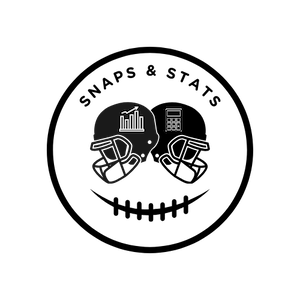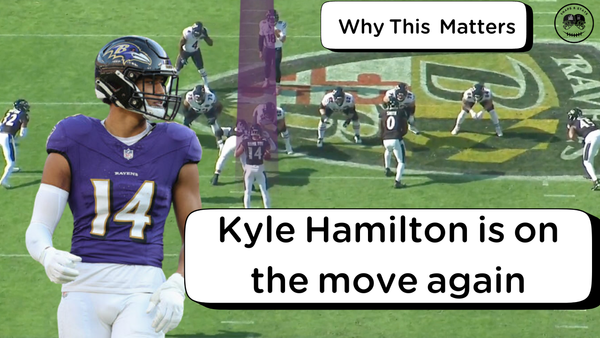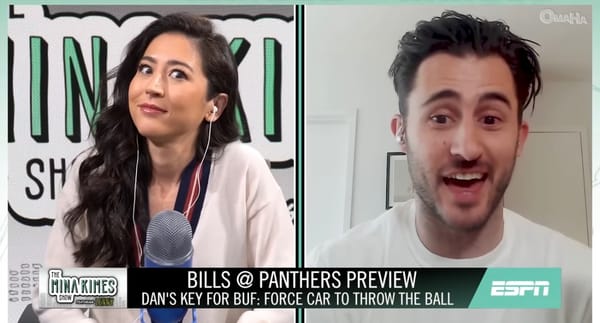The Watchlist: Week 7
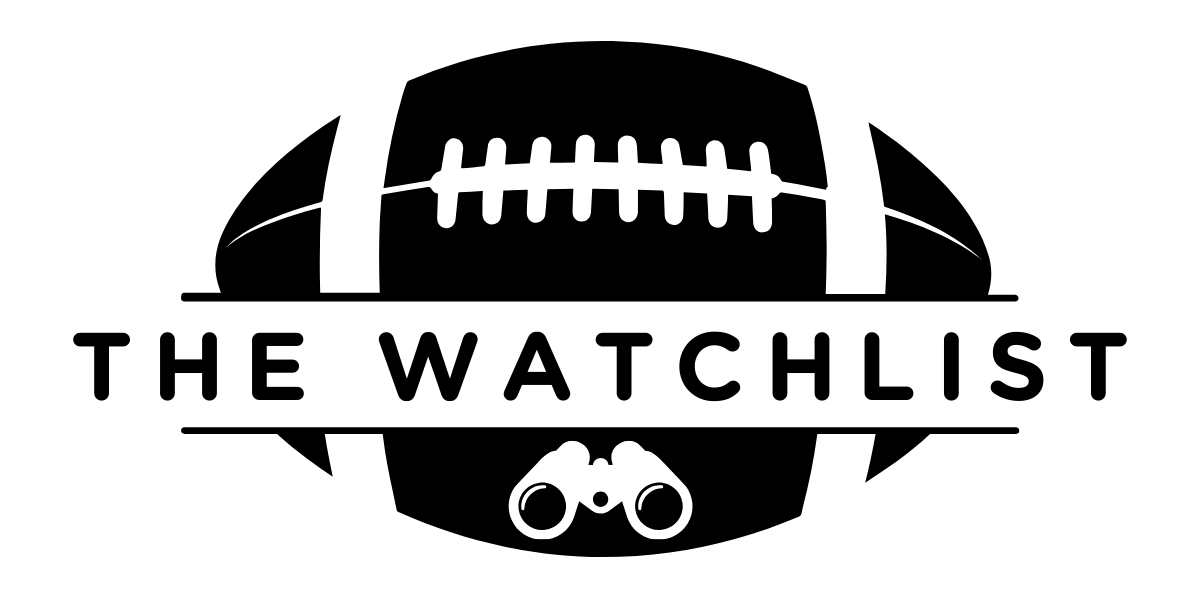
Welcome back to The Watchlist. Each week, we’ll go over a few things between players, matchups, and trends to keep an eye on for the upcoming week of games. For The Watchlist this week, we’ll look at three aspects, including a an offense picking up steam, another receiver adding a level to his game, and some dominant pass rushers against two quarterbacks impacted the most from pressure.
1. Rashee Rice returns to a good offense
The Chiefs are back and probably better than you think, especially on offense. Kansas City currently ranks second in offensive DVOA, second in yards per drive, third in points per drive, and second in the rate of drives that reach the red zone. This is all before Rashee Rice returns this week. Rice was a key piece to the passing game during his rookie season and in the first four games of the 2024 season before he was lost for the year.
Rice was a go-to receiver in the short and intermediate area and creating extra yards after the catch. Per Next Gen Stats, Rice had 147 yards after contact over expectation as a rookie, which ranked seventh among wide receivers, and he was already plus-47 in his four games played in 2024.
With Rice and Travis Kelce and the top targets for Patrick Mahomes, the quarterback’s average depth of target dropped as he worked more in the short area following the loss of Tyreek Hill. Here’s the passing heat map from Mahomes in 2023:
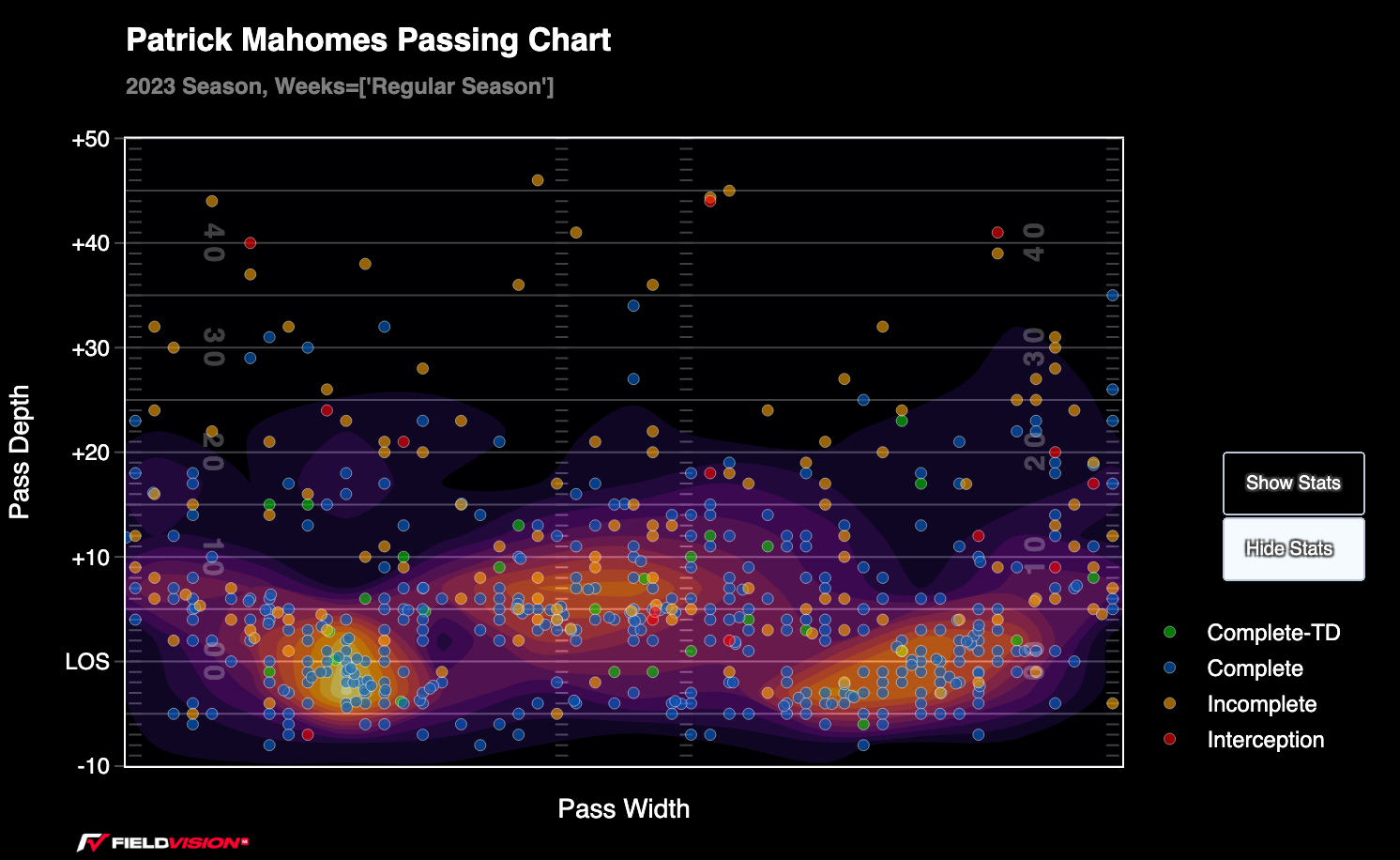
The 2023 offense worked because there were multiple options underneath and there was enough horizontal stretch to create space. After Rice got hurt, the Chiefs couldn’t do much to create space and the offense felt more condensed and there was no one else to take the attention from Kelce, who had less room to maneuver and struggled to consistently get open. Mahomes threw even shorter.
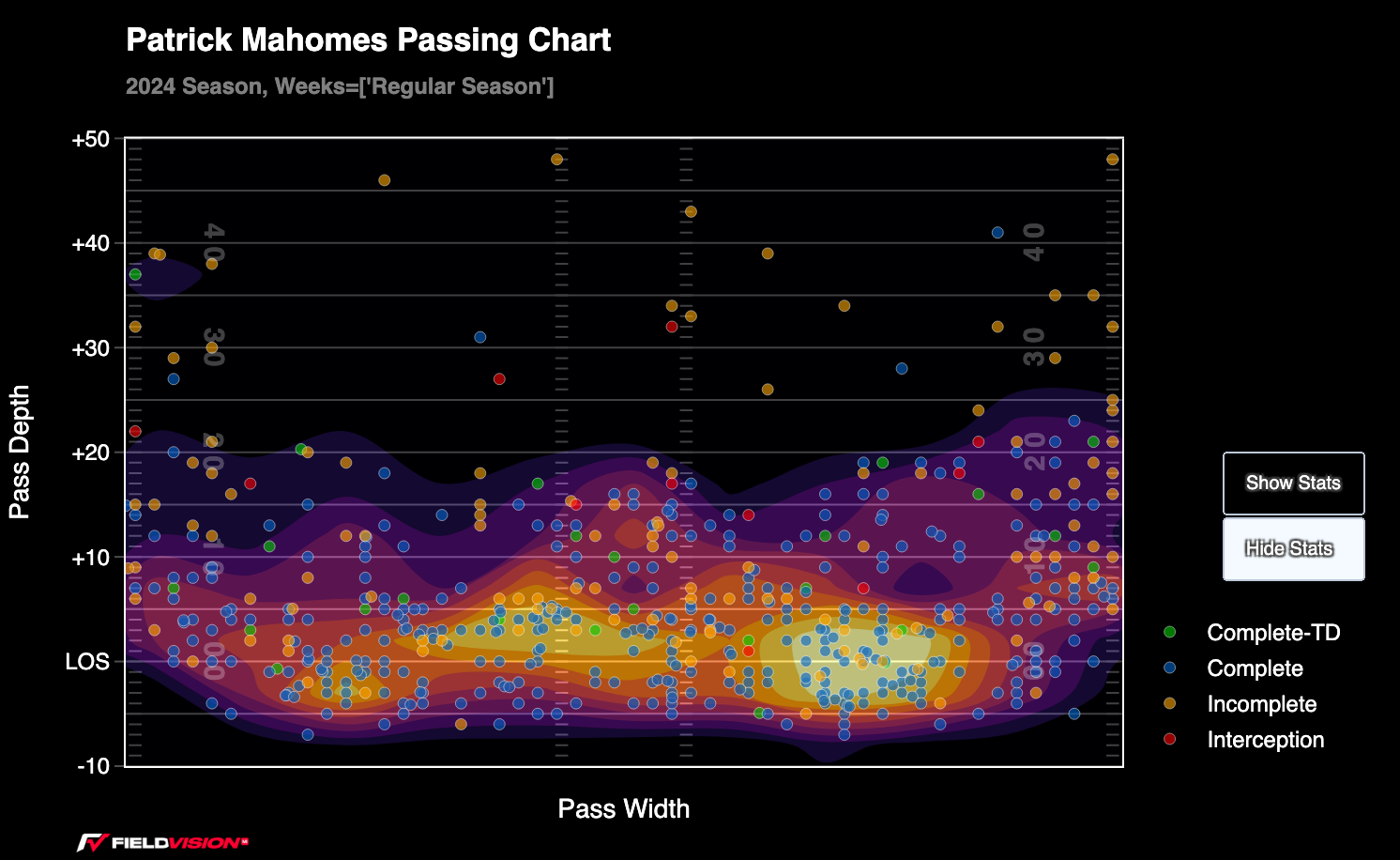
But this season, Mahomes has already pushed the ball down the field more often. Tyquan Thornton and Marquise Brown aren’t the league’s best deep threats but they have been useful enough for Mahomes to have his highest deep passing rate in a season since 2019, per NGS.
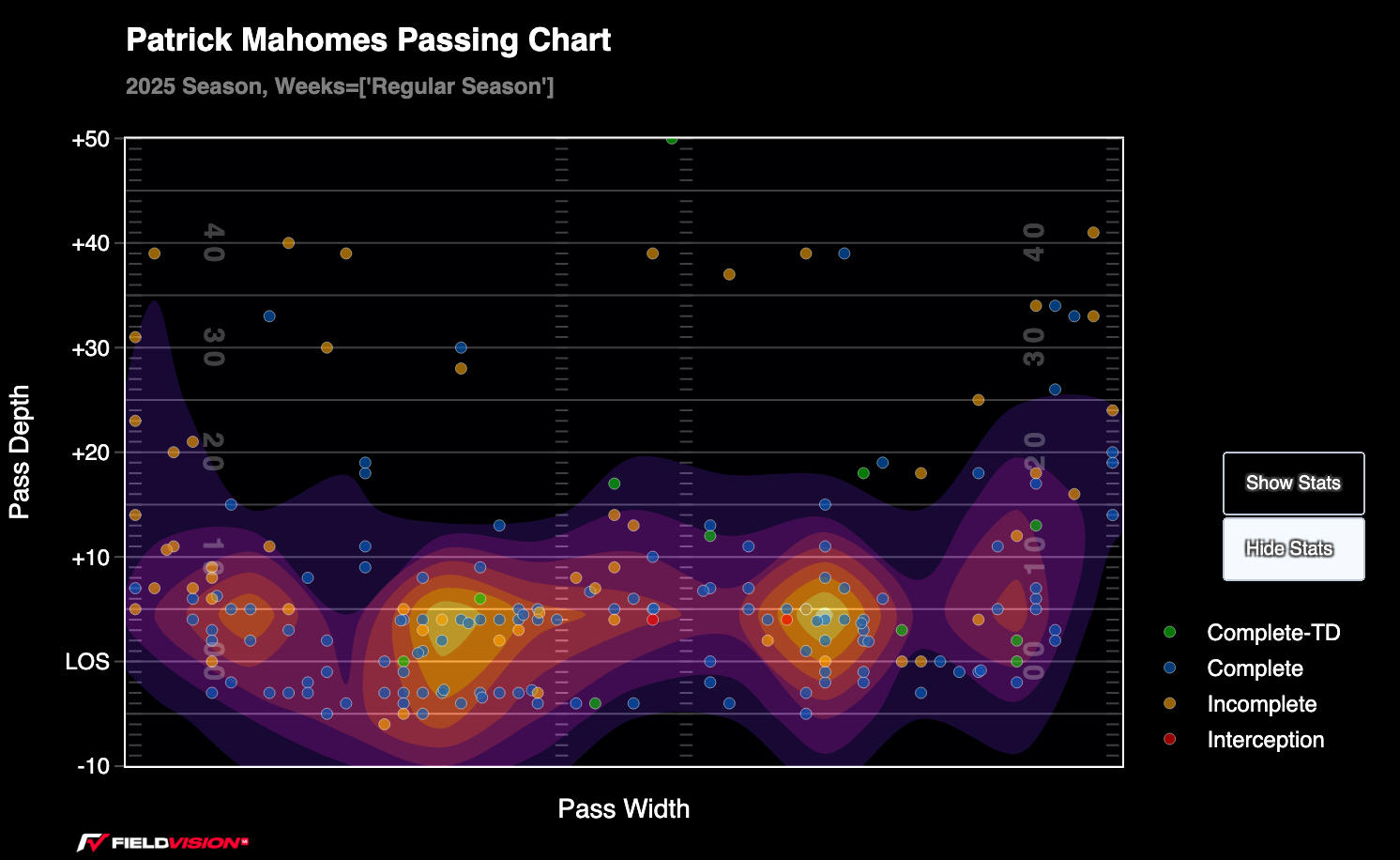
Mahomes has only completed 28% of his throws of 20 or more air yards this season, but he’s still 12th in EPA per attempt on those passes. The big plays have been meaningful when they’ve hit and more importantly there’s enough of a threat of the deep pass to open up the middle of the field again. Mahomes has seen more single-high this season, which has allowed him to take more of those deep shots. With Kelce playing well and Rice back on the field, defenses will have to choose between playing single-high to crowd the middle of the field or play single-high and let Mahomes take shots. For the first time in a while, the Chiefs could be dictating the coverages and not just reacting and defaulting to how defenses want to play them.
2. Amon-Ra St. Brown is getting open
Amon-Ra St. Brown has been one of the most productive receivers since he came into the league, but like Jaxon Smith-Njiba, he might be taking his game to another level in 2025. Per ESPN’s receiver tracking metrics, St. Brown has been better at getting open this season than he has over the previous three years.

Part of that has been St. Brown and the way he’s been able to get off the line and where he’s done that. St. Brown has played more outside snaps this season, but he’s also been put in a spot where that outside alignment has been weaponized. The Lions have been using late motion to get St. Brown into favorable spots, often motioning him into a stack on the outside.
On a second-and-12 against the Packers in Week 1, the Lions came out in 12 personnel and motioned St. Brown from a tight alignment with two tight ends to a stack with Jameson Williams on the other side of the formation. Williams ran vertical, which held the cornerback and safety up the seam, which left the sideline open for St. Brown.
Against the Ravens, the Lions sent St. Brown on a late short motion from inside to outside Williams. Baltimore was playing man coverage and Marlon Humphey never got squared up enough to stick with St. Brown, especially after a double move.
On this play against the Bengals, St. Brown motioned across the field and got a zone indicator with no defender following. He lined up stacked to the inside of Williams. They ran a switch release at the snap and Williams picked the inside defender, which opened up the inside for St. Brown, who made a linebacker miss in space and gained 16 yards on a second-and-9.
The Buccaneers have been the fourth-worst defense by EPA per play on passes with motion this season, per NGS. St. Brown leads the league in receiving EPA (20.7) on plays when he motions, nearly double the next receiver (11.7). So far, 28.9% of St. Brown’s routes have used some kind of motion. That’s up from 22.6% last season and 19.7% in 2023. The motion is also more purposeful, working to get St. Brown into advantageous spots and using that late motion to mess with defensive rules. It’s opened up some new places for the Lions to target and given an even wider range for defenses to have to account for one of the league's top wide receivers.
3. Broncos vs Giants Quick Pressure
The two leading players in creating quick pressures through six weeks are Nik Bonitto and Abdul Carter. They’re tied with 16 each, according to Next Gen Stats, and they’ll be on opposing defenses Sunday when the Broncos host the Giants.
Bonitto has done that by lining up outside of the left tackle and firing off the line on his way to a league-leading eight sacks.
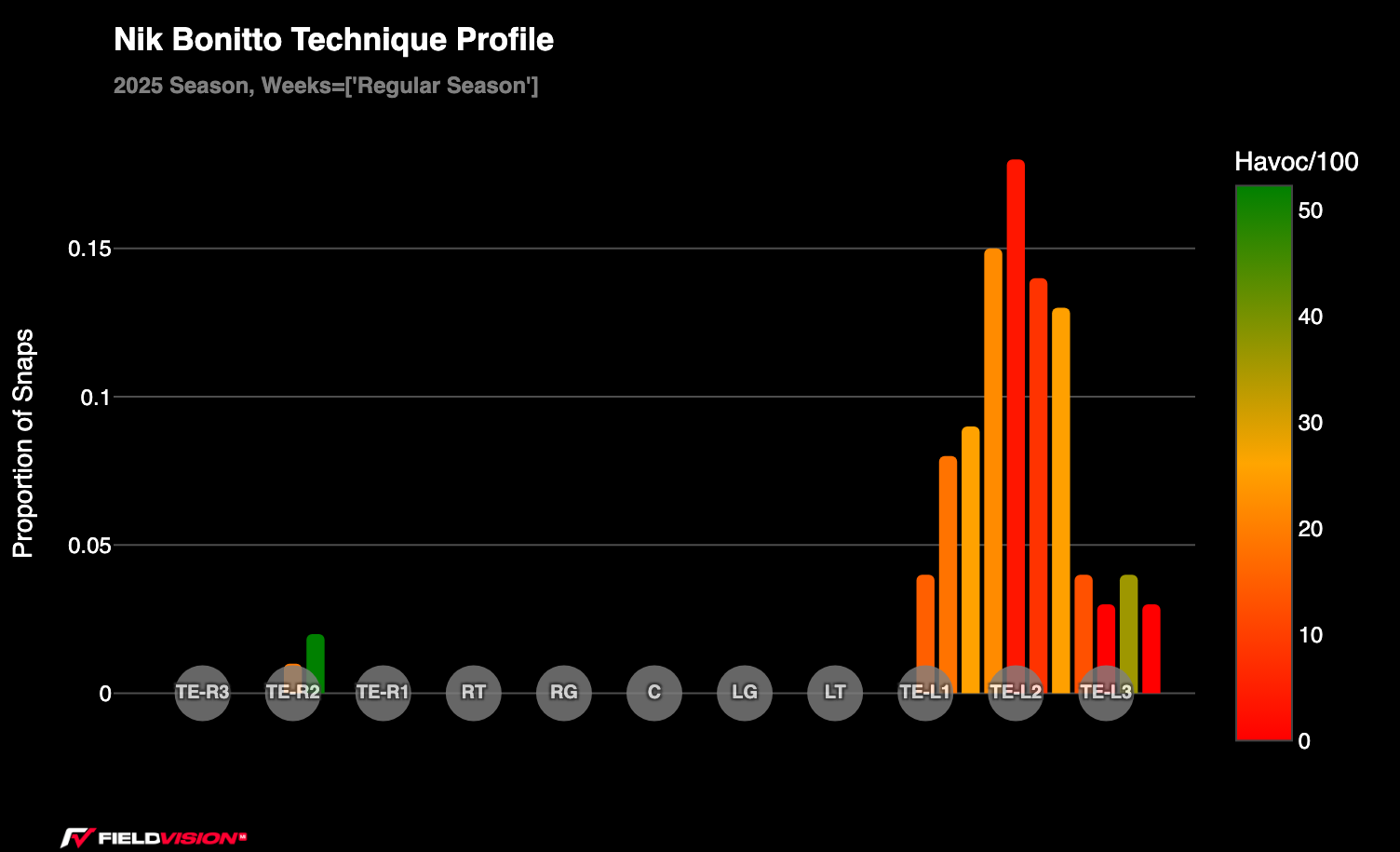
Meanwhile, Carter has lined up everywhere and has been a disruptive force despite only recording half a sack through the first six weeks of the season.

Bonitto has one of the fastest get-off times in the league (0.76 seconds). That dangerous on its own, but the leader in that metric lines up on the other side of the defense — Jonathan Cooper (0.72).
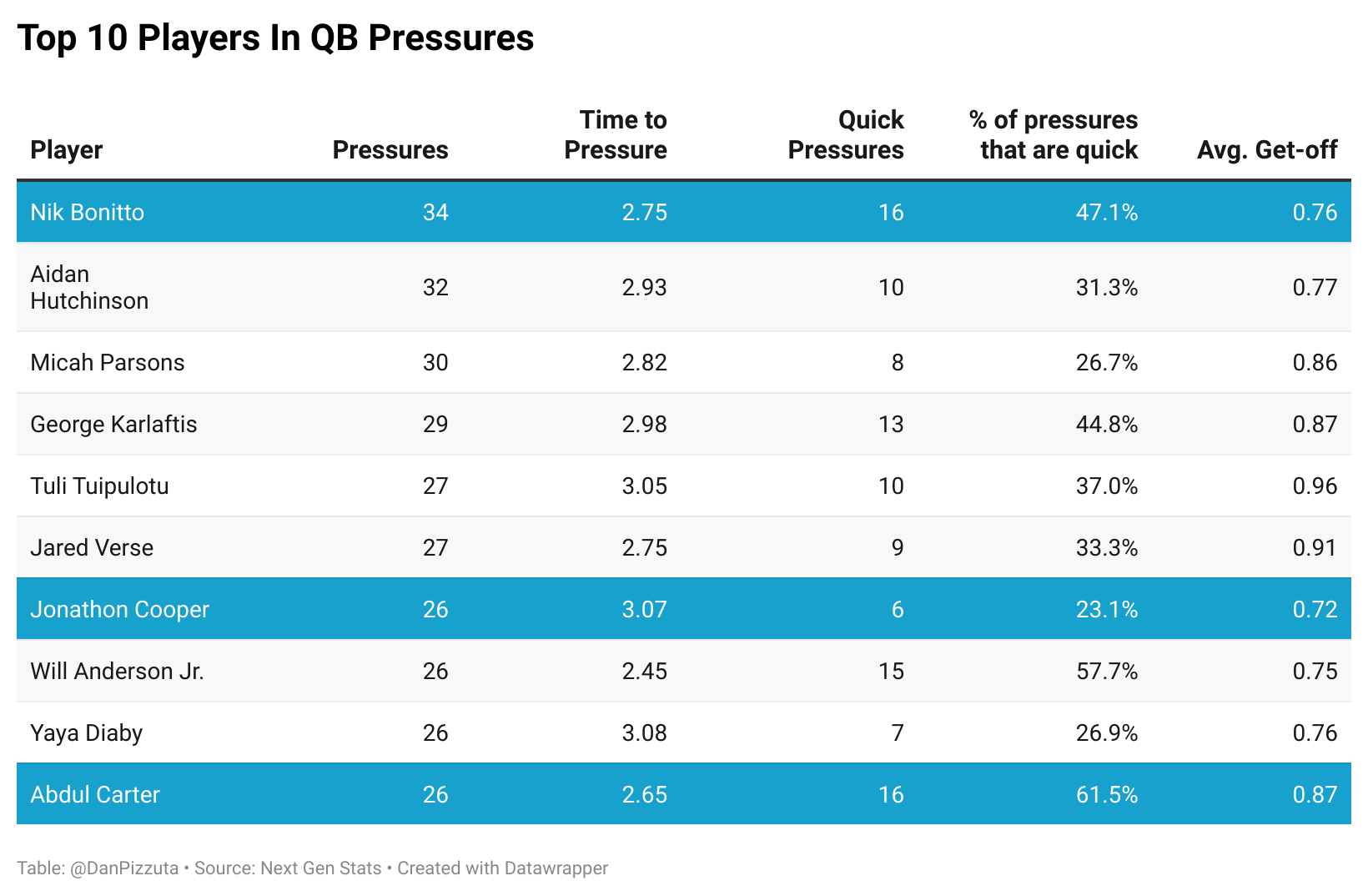
What makes these quick pressures so intriguing during this game is how the quarterbacks react to pressure. Bo Nix doesn’t take a lot of sacks. He has the fourth-lowest pressure-to-sack rate in the league but he’s still just 22nd in EPA per dropback against pressure. Nix has a tendency to flee the pocket but hasn’t been able to make much happen on the move whole has the third-highest throwaway rate among quarterbacks when under pressure. However, he’s 11th in success rate against pressure, per FTN, though few of those turn into big plays.
Despite the Giants’ big three in Carter, Brian Burns, and Kayvon Thibodeaux, alongside Dexter Lawrence, the Giants are only 19th in pressure rate. There’s been a lack of meshing the pass rush with the coverage consistently and there has been somewhere for the quarterback to go. Even with the Giants get pressure, they’re only 22nd in EPA per dropback.
The Broncos have been the best team this season at avoiding pressure altogether. Denver has the highest pass block win rate, per ESPN, and the fifth-lowest pressure rate faced, according to FTN. Nix has been kept in mostly safe pockets through his first season and a half, which has limited the damage from when pressure does arrive.
Nix has faced the lowest time to pressure in the league, because if pressure got through it’s likely because something went wrong quickly. That’s where Carter could come in.
On the other hand, Jaxson Dart has been pure chaos under pressure in his first few starts. He’s taken a sack on 26.8% of his pressures, the eighth-highest rate in the league, with a league-worst 7.7% success rate. He has the second-highest scramble rate at 19.2% and the highest aDOT at 14.4 yards, with the next-highest quarterback at 10.8. Dart is just 2-of-18 on throws under pressure this year.
While he got some throws off against the Eagles last Thursday night, his play has been erratic when defenders close in. He’s been hit on 57.7% of his pressures, the sixth-highest rate in the league, which doesn’t account for the many open-field hits he’s taken as a runner.
Outside of the pass rushers who can win easily off the edge, the Broncos have the highest rate of Cover-0. On 7.8% of the Broncos’ pass snaps, they’re playing zero coverage. They’re also playing zero on 20.8% of their bliztes, the highest rate in the league, per MatchQuarters.
This is going to be the biggest defensive test of Dart’s early career and how he handles it could go a long way in setting expectations for the remainder of the season after there’s been some excitement following his first three games.
